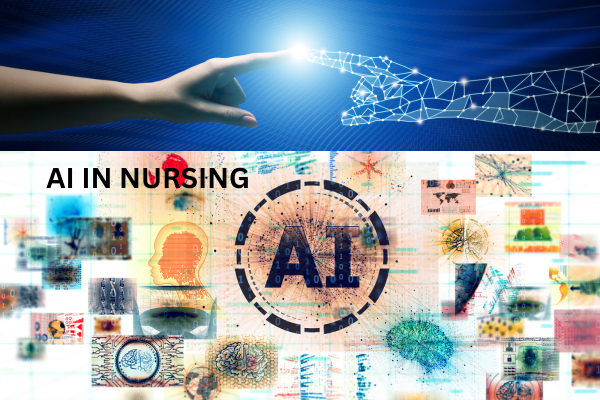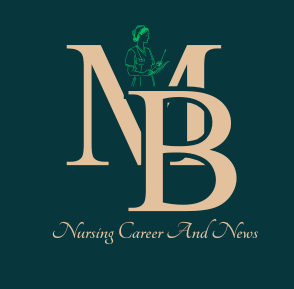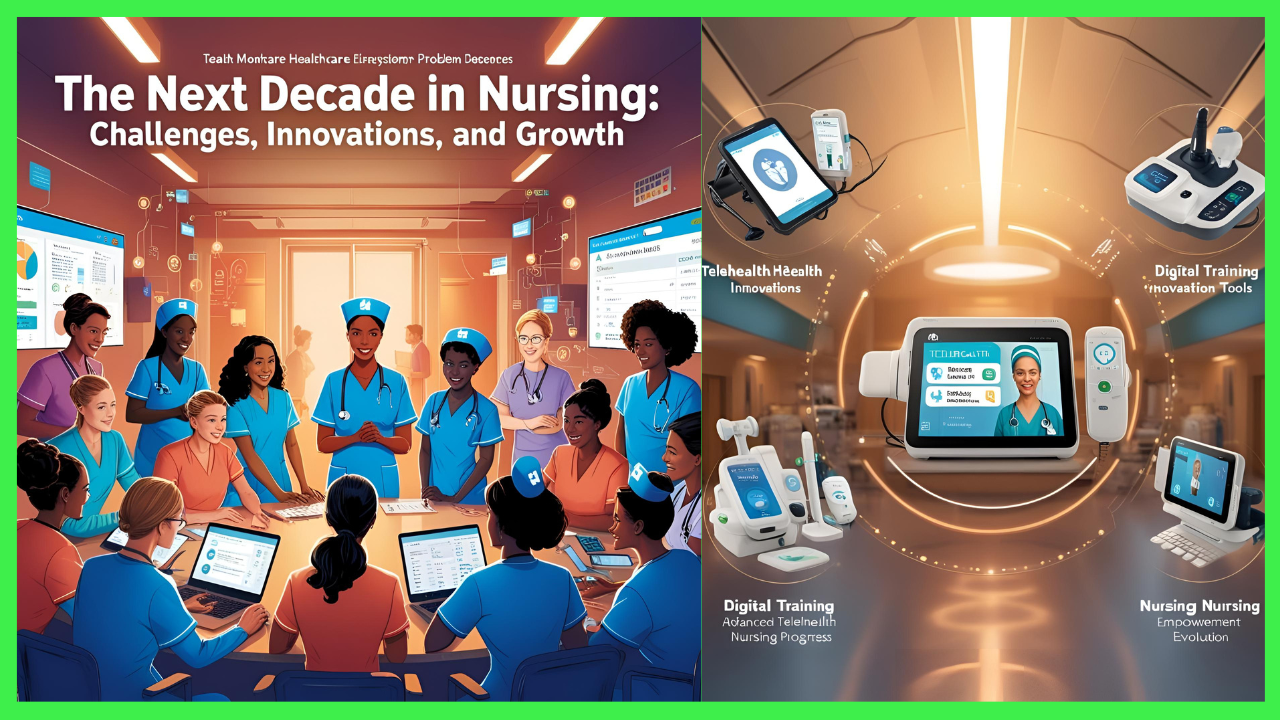The Next Decade in Nursing: Challenges, Innovations, and Growth
Overview
The nursing industry is changing quickly due to workforce issues, shifting healthcare needs, and technology improvements. Nurses will be increasingly involved in determining patient care, embracing digital advancements, and tackling global health issues over the course of the next ten years. Nursing practitioners may keep ahead of the curve, adjust to changing needs, and guarantee high-quality patient care by being aware of current developments.
This article examines the major themes influencing nursing’s future, the difficulties that nurses will encounter, and the advancements that are revolutionizing the medical field.

Artificial Intelligence (AI) in Nursing’s Ascent
AI has the potential to completely transform nursing by advancing clinical decision-making, automating administrative duties, and boosting diagnostics. Nurses will be able to identify patients at risk for consequences before symptoms manifest with the aid of AI-driven predictive analytics. How AI Will Affect Nursing Automated Documentation: AI technologies can save paperwork by streamlining the administration of electronic health records (EHRs). AI chatbots will help nurses with basic triage and patient inquiries as virtual nursing assistants. Improved Diagnostics: AI systems will assist in identifying early disease indicators, leading to better patient outcomes.

- Remote Patient Monitoring (RPM) and Telehealth
Telehealth became a permanent component of healthcare due to the COVID-19 pandemic, which expedited its acceptance. Hospital readmissions will be decreased by nurses being able to track patients with chronic diseases in real-time through remote monitoring. Important Developments in Nursing Telehealth Wearable Technology Nurses will be able to remotely check on patients’ vitals thanks to smartwatches and biosensors. Virtual Nursing Consultations: By using video chats to deliver care, nurses will make themselves more accessible to patients in remote areas. Chatbots Powered by AI These resources will assist nurses in attending to patients’ needs around the clock. - Nurse Practitioners’ (NPs’) Growing Role
Nurse practitioners will assume greater responsibility, particularly in primary care, as a result of the growing physician shortage. By 2030, the demand for NPs is predicted to increase by 40%. The Reasons NPs Will Be in High Demand to Close Primary Care Gaps NPs are being given full practice authority by more states. Enhancing Access to Care: NPs can work in underprivileged communities with a shortage of physicians. Reducing Healthcare Costs: NPs offer high-quality, reasonably priced patient care. - The Transition to Preventive and Holistic Care
The focus of healthcare is shifting from treating illnesses to preventing them. When it comes to teaching patients about mental health, chronic disease prevention, and nutrition, nurses will be essential. Prospective Developments in Preventive Nursing Care
Including Mental Health in Nursing Practice Mental health support training will be provided to nurses. - Lifestyle Coaching: Nurses will provide patients advice on stress reduction, exercise, and nutrition.
- Community Health Programs: To stop illness outbreaks, nurses will work in public health.
- How Nursing Is Affected by the Aging Population
The need for geriatric nurses will rise since one in five Americans will be over 65 by 2030. More Home Healthcare Nursing Jobs as a Result of an Aging Population: Patients choose in-home care over nursing homes. Specialized Geriatric Training: Nurses will learn more about dementia and other age-related illnesses. Enhanced Attention to Palliative Care: Nurses will offer sympathetic care for patients nearing the end of their lives. - Issues and Shortages in the Nursing Workforce
As a result of high turnover rates, an aging workforce, and burnout, the nurse shortage is predicted to reach 1.1 million by 2030. Methods for Resolving Nursing Shortages
Increased Pay and Benefits In order to keep nurses on staff, hospitals will pay them more. Adaptable Work Schedules There will be an increase in remote and part-time nursing positions. More financing for nursing training programs and scholarships is needed for advanced nursing education.

- The Value of Nurses’ Knowledge of Digital Health
Nurses will need to stay current on telehealth platforms, data analytics, and electronic health records (EHRs) as healthcare becomes more technologically advanced. How Nurses Can Develop Their Digital Health Proficiency
Programs for Ongoing Training: Hospitals will offer continuing technical instruction. AI-Assisted Decision Support Systems: To improve patient care, nurses will employ AI technologies. Cybersecurity Awareness: Nurses will receive instruction on safeguarding patient information. - Robotics Integration in Nursing
Assisting with duties like patient lifting, medicine delivery, and room disinfection, robots are emerging as useful nursing assistants. Examples of Nursing Robots: Exoskeletons let nurses lift patients with less physical effort. Automated Medication Dispensers: Guarantee precise dosage and minimize mistakes. Elderly patients can receive emotional assistance from companion robots. - Inclusion and Diversity in Nursing
In order to deliver better patient-centered care, nursing in the future will prioritize cultural competency. More Minority Nurse Scholarships: Promoting diversity in nursing schools is one of the main initiatives for diversity in nursing. Meeting the requirements of various patient populations with bilingual nursing staff. Teaching nurses how to interact across cultural boundaries is known as cultural competency training. - Nursing Education’s Future
With the advent of virtual simulations and online learning, nursing education will become more adaptable and technologically advanced. Future Developments in Nursing Education
Nurses will practice operations in virtual simulations as part of virtual reality (VR) training. More nurses will obtain degrees remotely thanks to online degree programs. AI-Powered Learning Platforms: Tailored education according to a nurse’s proficiency level. Questions and Answers (FAQs) - What will be the main obstacles facing nurses in the upcoming ten years?
The aging population will result in increased patient loads, workforce shortages, and technological adaptation for nurses. - What impact will AI have on nursing?
AI will lessen the workload of nurses by streamlining documentation, enhancing patient monitoring, and improving diagnosis. - Will nurses have greater employment options?
Indeed! By 2030, there will be a 9% increase in demand for nurses, particularly in the telemedicine, mental health, and geriatric sectors. - What abilities will be required of future nurses?
Digital health literacy, critical thinking, emotional intelligence, and technological proficiency are all necessary for nurses. - How can nurses keep up with emerging trends?
Nurses can follow medical publications, participate in continuing education courses, and attend workshops. - In conclusion
Nursing will undergo significant change over the next ten years, from telemedicine and advanced nursing positions to artificial intelligence and robotics. The future of healthcare innovation will be led by nurses who are flexible, accept technology, and develop their abilities. The nursing profession can continue to provide excellent, patient-centered care by getting ready for these new developments.


2 thoughts on “The Next Decade in Nursing: Challenges, Innovations, and Growth”